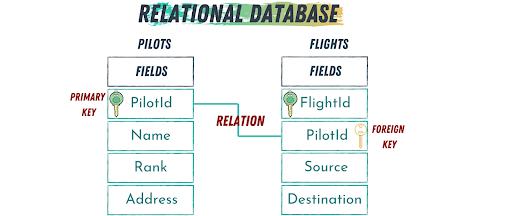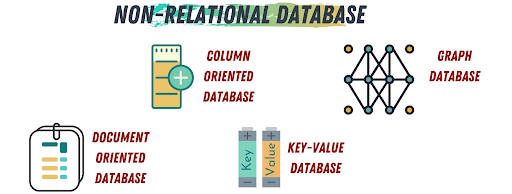Both SQL and NoSQL are used to categorize and communicate with different database management systems (DBMS), specifically relational and non-relational databases.
SQL interacts with relational databases, while NoSQL interacts with non-relational databases.
SQL vs. NoSQL: What’s the Difference?
- SQL: a programming language used to interact with relational databases; SQL databases have an established, fixed schema design and structure.
- NoSQL: an approach to database design that describes non-relational databases; NoSQL databases have a flexible and easily scalable schema design and structure.
What Is SQL?
SQL, or Structured Query Language, is a programming language used for managing and manipulating relational databases and their associated data.
In relational databases, data is stored in different tables, each containing multiple records (rows). These tables are connected to each other using one or more relations. SQL lets users add, remove and retrieve data from these rows within the database.
MySQL and PostgreSQL are examples of relational database management systems that utilize SQL.
What Is NoSQL?
NoSQL, often short for “not only SQL,” describes databases that are non-relational, meaning they are flexible and able to manage data outside of the tabular format used in relational databases.
Non-relational databases don’t store data in tables and records. Instead, the data storage structure is designed and optimized for specific requirements.
MongoDB and Cassandra are examples of non-relational database systems, and follow NoSQL design and structure.
How Does SQL Work?
Properties
SQL is a portable, secure and declarative programming language. It’s built for supporting basic data structures and large data sets within relational databases, and it is best-suited for handling structured data.
In SQL, keys define the relation between the tables. A key is the table field (column) that contains unique values for each record. If a field is defined as a table’s primary key, this field can be included in multiple tables and can be used to access different tables simultaneously. Once a primary key connects one table to another, it will become known in the other table as a foreign key.

Storage
SQL often allows for faster data storage and recovery, and works better with complex queries.
Performance
SQL is able to read large sets of data quickly in comparison to NoSQL, making it useful for scenarios where several data reading tasks need to be completed at once. SQL also requires a schema to be defined in databases before storing and retrieving data, though, so SQL databases can take a longer time to prep in comparison to NoSQL databases.
SQL is a better choice if you’re dealing with an RDBMS (relational database management system) and want to analyze the data’s behavior or want to build custom dashboards.
Scalability
SQL scales vertically when scaling data, meaning its systems require additional hardware or server resources to increase its processing power. SQL databases are older so they have a more established and fixed schema design and structure.
How Does NoSQL Work?
The four popular types of NoSQL databases are column-oriented, document-oriented, key-value pairs and graph databases. You can use these types individually or you can combine them. The choice will depend on your application and the type of data you need to store.

Properties
NoSQL databases are built to support multiple different data models and be versatile in data handling and distribution needs. They’re easily scalable and flexible, making them equally suited for handling structured, semi-structured and unstructured data.
Instead of SQL, which is what relational databases use, NoSQL databases use object-relational-mapping (ORM) to facilitate communication with its data.
Storage
In a document-oriented database, the structure of the data sorted isn’t so rigid. Instead, the data is stored as a collection of fields and data values together in the structure of a document. A benefit of using a document-oriented database is that documents don’t all need to have the same structure, so different data types can be sorted within the same database. These document-oriented databases are often stored as JSON strings and can be encoded using YAML, XML or as plain text to protect the data.
In a column-oriented database, the data is stored and organized as columns. This type of database is beneficial if you need to store sparse data.
In a key-value database, every data object in the database will be stored as a pair: a key and a value. How it stores can be thought of as a Python dictionary if you’re familiar with Python.
Graph databases allow you to implement the interconnection of the data efficiently when data is highly interconnected. Graph databases are considered the most complex NoSQL database, but are also versatile, which make them a great fit for many applications.
Performance
NoSQL databases don’t require a schema to be defined before storing and retrieving data, making it a more accessible structure for immediate data handling. However, being able to take in unstructured and semi-structured data means some data may be incorrect or malformed upon input, and cannot easily be analyzed.
NoSQL databases are the better choice if you want to expand upon RDBMS’s standard structure, or you need to create a flexible schema. NoSQL databases are also better when the data you’re storing and logging is coming from distributed sources, or you just need to store it temporarily.
Scalability
NoSQL scales horizontally when scaling data, meaning it increases its processing capacity by adding more nodes or distributed computers to its systems, in turn spreading out its workload across multiple points.
When to Use SQL vs. NoSQL
So, how can we choose between SQL and NoSQL databases?
There are four aspects you need to consider in order to answer this question: flexibility, scalability, consistency and available technology.
1. FLEXIBILITY
Sometimes your data has different structures and different types. By definition, NoSQL databases give you more freedom to design your schema and store different data structures within the same database. SQL databases, on the other hand, have a more rigid structure and schema.
2. SCALABILITY
Have you ever seen a Japanese car parking elevator? It allows you to park cars on top of each other. Now, ask yourself this: Which will be more efficient, adding levels to the elevator or building new elevators? SQL databases are vertically scalable, which means you can add levels to it (increase the load) while NoSQL databases are horizontally scalable, meaning you can increase its load by dividing the work over multiple servers.
3. CONSISTENCY
SQL databases have a highly consistent design. However, a NoSQL database can be consistent (or not) based on DBMS. For example, MongoDB is consistent, while a database like Cassandra is not.
4. AVAILABLE TECHNOLOGY
One aspect you might consider is the current stage of development of the database technology. SQL has been around since the 1970s and has experienced a longer timeline of development, while NoSQL was only first used in the 1990s. So, for beginners, starting with SQL and then moving to NoSQL might be the best choice.
How to Choose Between SQL and NoSQL
In the end, I can’t say that SQL is absolutely better than NoSQL or the way around. Each one has its own advantages and disadvantages, and you should make your choice based on your data, its application and what makes the development process easier for you.
So, what are the requirements of your data? Is your data well-structured? Are you dealing with a large amount of data?
Listen to your data and you’ll make the best choice.





